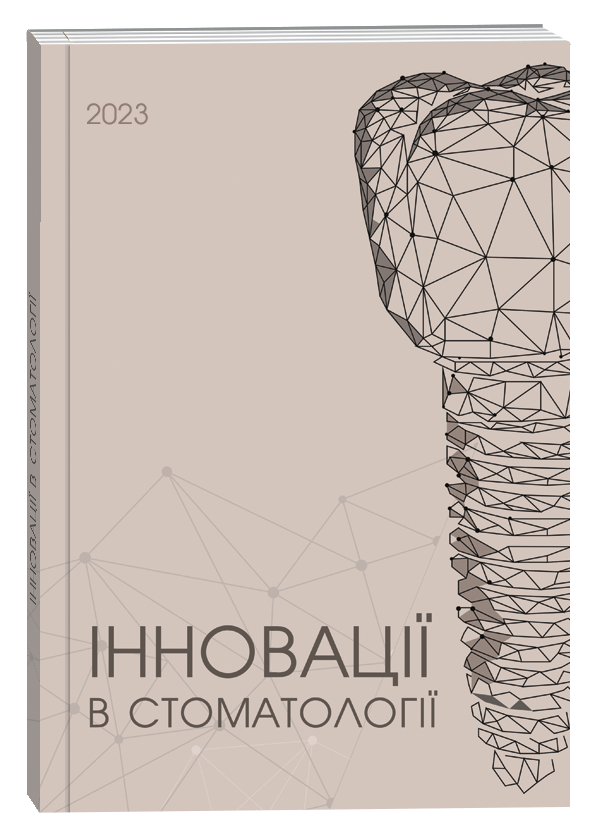PREVALENCE OF CARIES OF PERMANENT TEETH IN CHILDREN AGED 6–12 YEARS WITH DENTOALVEOLAR ANOMALIES
DOI:
https://doi.org/10.35220/2523-420X/2025.2.21Keywords:
children, caries, permanent teeth, dental anomaliesAbstract
Today, the prevalence of permanent tooth decay and dental anomalies among children is high worldwide and in Ukraine in particular, and has no tendency to decrease.Many scientific studies show a link between these dental pathologies. However, there are also studies that have found contrary results that do not support this link.Therefore, these diverse data encourage us to conduct further research to assess the condition of the hard tissues of permanent teeth in children aged 6-12 years with dentoalveolar anomalies. Research methods. To achieve this goal, 119 children aged 6-12 years with dental caries (main group) and 103 children of the same age (comparison group) who studied at the O. Kovch Przemysl secondary school were examined in the dental department of the Municipal Enterprise «Przemysl Central District Hospital». The children were examined in accordance with the main provisions of the Declaration of Helsinki for Biomedical Research (Seoul, 2008) with informed parental consent. The prevalence of caries was determined in%, and the intensity of caries was determined by the CPV index. The study results were statistically analysed using the Student's t-test. Scientific novelty. As a result of the study, it was found that in children with PJD the prevalence of caries of permanent teeth, on average, was 89.92±2.76% with an intensity of 3.22±0.34 teeth, and in children without PJD – 78.64±4.04% and 1.96±0.26 teeth, respectively. The highest prevalence of caries in permanent teeth was found among girls aged 9-12 years with GPA (96.87±3.08%), and the lowest among boys aged 6-8 years without GPA (68.00±9.33%). It was found that the intensity of caries of permanent teeth in 6-8-year-old children with VHD was 34.18% higher than in children without VHD. Among 9-12-year-old children, this difference was 41.52%. It was found that from 6-8 years to 9-12 years, the value of the CPV index in children with TMD increased by 2.28 times, and in children without TMD by 2.03 times. It was found that in both groups of children aged 6-8 years and in 9-12 years old children without dental caries, the number of carious unsealed teeth was 52.31%, 18.57% and 61.49% higher than the number of sealed teeth. In contrast, in 9-12-year-old children with dental caries, the number of filled teeth was 42.08% higher than the number of carious teeth. Conclusions. The results of the study indicate a higher level of caries in permanent teeth in children with TMD compared to children without TMD, which indicates a possible relationship between these dental pathologies. The high intensity of caries of permanent teeth in the examined children indicates an insufficient level of sanitation and the need to motivate parents and children to maintain dental health.
References
Global oral health status report: towards universal health coverage for oral health by 2030. Geneva: World Health Organization; 2022. 100 р. Available from: https://apps.who.int/iris/rest/bitstreams/1479338/retrieve
Canadian Dental Association [Internet]. Oral Health: A Global Perspective. The State of Oral Health in Canada. [cited 5 August 2024]. https://www.cda-adc.ca/stateoforalhealth/global/
Lana Alshayeb, Mayssoon Dashash. Prevalence and clinical risk factors of dental caries in Syrian children: a cross-sectional study. Sci Rep. 2025. №15. Р. 10721. DOI: 10.1038/s41598-025-95534-5
Qadir Khan S., Alzayer H.A., Alameer S.T., Ajmal Khan M., Khan N., Al Quorain H., Gad M.M. SEQUEL: Prevalence of dental caries in Saudi Arabia: A systematic review and Meta-analysis. Saudi Dent J. 2024. №36(7). Р. 963-969. DOI: 10.1016/j.sdentj.2024.04.011.
Obregón-Rodríguez N., Fernández-Riveiro P., Piñeiro-Lamas M., Smyth-Chamosa E., Mon- tes-Martínez A., Suárez-Cunqueiro M.M. Prevalence and caries-related risk factors in schoolchildren of 12- and 15-year-old: a cross-sectional study. BMC Oral Health. 2019. №19(1). Р. 120. DOI: 10.1186/s12903-019-0806-5.
de Albuquerque L.S., de Queiroz R.G., Abanto J., Strazzeri Bönecker M.J., Soares Forte F.D., Sampaio F.C. Dental Caries, Tooth Loss and Quality of Life of Individ- uals Exposed to Social Risk Factors in Northeast Brazil. Int J Environ Res Public Health. 2023. №20(17). Р. 6661. DOI: 10.3390/ijerph20176661.
Трубка І.О., Удод О.А., Савичук Н.О., Кор- нієнко Л.В., Єрмакова Л.Г., Драмарецька С.І., Волошин,В., Маркова Н.А. Карієс зубів та стан ясен у дітей шкільного віку з різних регіонів України. Сучасна медицина, фармація та психологічне здоров’я. 2023. №2(11). С. 49-55. DOI: 10.32689/2663-0672-2023-2
Прощенко Н.С., Сороченко Г.В., Остапко О.І. Плиска О.М., Трохимець Ю.В. Ускладнений карієс постійних зубів у дітей: стан проблеми та сучасні шляхи вирішення. Медичні перспективи. 2023. Т. 28, № 3. С. 128-136. DOI: 10.26641/2307-0404.2023.3.289211
Дуда К.М., Лебідь О.І. Поширення стоматологічних захворювань серед дітей віком 6–9 років. Клінічна стоматологія. 2019. №1. С. 48-51. DOI: 10.11603/2311-9624.2019.1.10147
Янчук А.О., Скиба В.Я., Катеринчук І.П., Кузніченко С.О., Скиба О.В. Епідеміологічні дослідження та моніторинг стоматологічної захворюваності у дітей України. Світ медицини та біології. 2019. № 2(68). С. 154-158. DOI 10.26724/2079-8334-2019-2- 68-154-158
Каськова Л.Ф., Мандзюк Т.Б., Уласевич Л.П., Андріянова О.Ю., Янко Н.В. Порівняльна характеристика показників карієсу у дітей різного шкільного віку. Буковинський медичний вісник. 2019. № 23(2). С. 10-15.
Дорошенко С.І., Савонік С.М. Поширеність зубощелепних аномалій у дітей віком 4-17- ти років. Сучасна стоматологія. 2020. № 5. С. 70-72.
Заяць О.Р., Ожоган З.Р. Поширеність зубощелепних аномалій у дітей Івано-Франківської області. Сучасна стоматологія. 2020. № 1. С. 68-72.
Потапчук А.М., Мельник В.С., Горзов Л.Ф., Алмаші В.М. Поширеність та структура зубощелепних аномалій у дітей забруднених територій екосистеми Верхнього Полісся. Сучасна стоматологія. 2019. № 2. С. 50-55.
Mai W., Xiao L., Chen S., Chen S., Li A., Zhang T., He H., Zeng X. Prevalence and contributing factors of malocclusion in Zhuang children aged 7-8 years in south- ern China. Front Pediatr. 2024. №12. Р. 1308039. DOI: 10.3389/fped.2024.1308039. PMID: 38288319; PMCID: PMC10822886.
Pan Y., Gui Z., Lyu J., Huang J. The prevalence of malocclusion and oral health-related quality of life among 12- and 15-year-old schoolchildren in Shanghai, China: a cross-sectional study. BMC Oral Health. 2024. №24(1). Р. 1315. DOI: 10.1186/s12903-024-05077-w. PMID: 39472886; PMCID: PMC11523641.
Singh A., Purohit B. Is Malocclusion Associated with Dental Caries among Children and Adolescents in the Permanent dentition? A Systematic Review. Community Dent Health. 2021. №38(3). Р. 172-177. DOI: 10.1922/ CDH_00340Singh06. PMID: 33780175.
Salim N.A., Alamoush R.A., Al-Abdallah M.M., Al-Asmar A.A., Satterthwaite J.D. Relationship between dental caries, oral hygiene and malocclusion among Syrian refugee children and adolescents: a cross-sectional study. BMC Oral Health. 2021. №21(1). Р. 629. DOI: 10.1186/ s12903-021-01993-3.
Лесіцький М.Ю., Кисіль А.Р. Ураженість каріє- сом постійних зубів у дітей із зубощелепними аномаліями. Інновації в стоматології. 2024. № 1. С. 78-84. DOI: 10.35220/2523-420 X/2024.1.11
Arora G., Bhateja S. Prevalence of dental caries, periodontitis, and oral hygiene status among 12-year- old schoolchildren having normal occlusion and maloc- clusion in Mathura city: a comparative epidemiological study. Indian J Dent Res. 2015. №26(1). Р. 48-52. DOI: 10.4103/0970-9290.156801. PMID: 25961615.
Vellappally S., Gardens S.J., Al Kheraif A.A., Krishna M., Babu S., Hashem M., Jacob V., Anil S. The prevalence of malocclusion and its association with dental caries among 12-18-year-old disabled adoles- cents. BMC Oral Health. 2014. №14. Р. 123. DOI: 10.1186/1472-6831-14-123. PMID: 25273325; PMCID: PMC4190396.
Смоляр Н.І., Федорів Я.М., Завойко Л.М. Мето- дичні рекомендації по статистичній обробці / [уклад. Смоляр Н. І., Федорів Я.М., Завойко Л. М. та ін]. Львів, 1995. 17 с.








